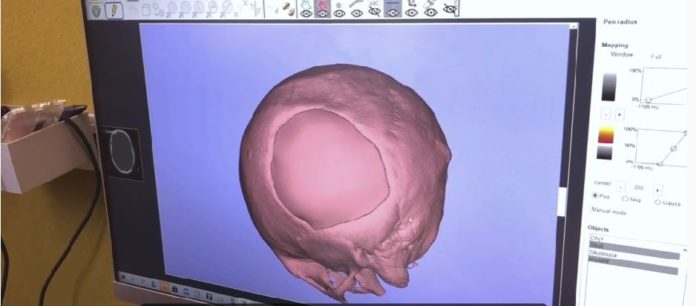Cranioplasty is the surgical repair of skull fractures or deformities. These fractures and deformities can happen as the result of a neurosurgical operation that required access to the brain, a traumatic accident, or a birth defect.
As any operation that is performed in the brain, such surgical repair is complex and requires highly intensive preparation.
The healthcare team from Skåne University Hospital explored the use of 3D printing for this brain surgery. A team of medical engineers and doctors utilized CT images to design and 3D print a custom implant that fits the patient’s skull. They used a specifically adapted and well-tested biocompatible plastic material for the production process.
According to our sources, the 3D printer used for this procedure is the Apium M220 3D printer from Apiumtec, a machine designed specifically for medical products and implants made out of PEEK. The machine features a sterile printing environment, a new extrusion technology and is perfectly compatible with Evonik’s materials.
The VESTAKEEP PEEK biomaterial from Evonik unveiled in June 2021 was the material of choice for this procedure. With body contact up to 30 days, the filament ensures biocompatibility and delivers excellent temperature and chemical resistance, very good sterilizability, and easy handling.
Recently, the first surgery was performed with a 3D printed cranioplasty implant produced at Skåne University Hospital. The surgery was part of a ‘one-size-fits-all’ study.
“The surgery was successful. The patient is a 40-year-old woman who, after an accident, needed a cranioplasty. The study hopes to show that the surgeries can be carried out more quickly and that the risk of infections is reduced. Specifically adapted implants also reduce the risk of skin damage and enable our patients to recover faster”, comments Peter Siesjö, consultant in Neurosurgery and Pain Rehabilitation at Skåne University Hospital and professor at Lund University.
Some of the reasons why a patient needs cranioplasty are injuries, tumors and infections.
Einar Heiberg Brandt, medical engineer in Clinical Physiology and Nuclear Medicine at Skåne University Hospital and Wallenberg Centres for Molecular Medicine, identifies many possibilities with the new method.
“This is only the beginning. There are no barriers to writing other types of bone implants”, he concludes.
Remember, you can post job opportunities in the AM Industry on 3D ADEPT Media free of charge or look for a job via our job board. Make sure to follow us on our social networks and subscribe to our weekly newsletter : Facebook, Twitter, LinkedIn & Instagram ! If you want to be featured in the next issue of our digital magazine or if you hear a story that needs to be heard, make sure to send it to contact@3dadept.com



